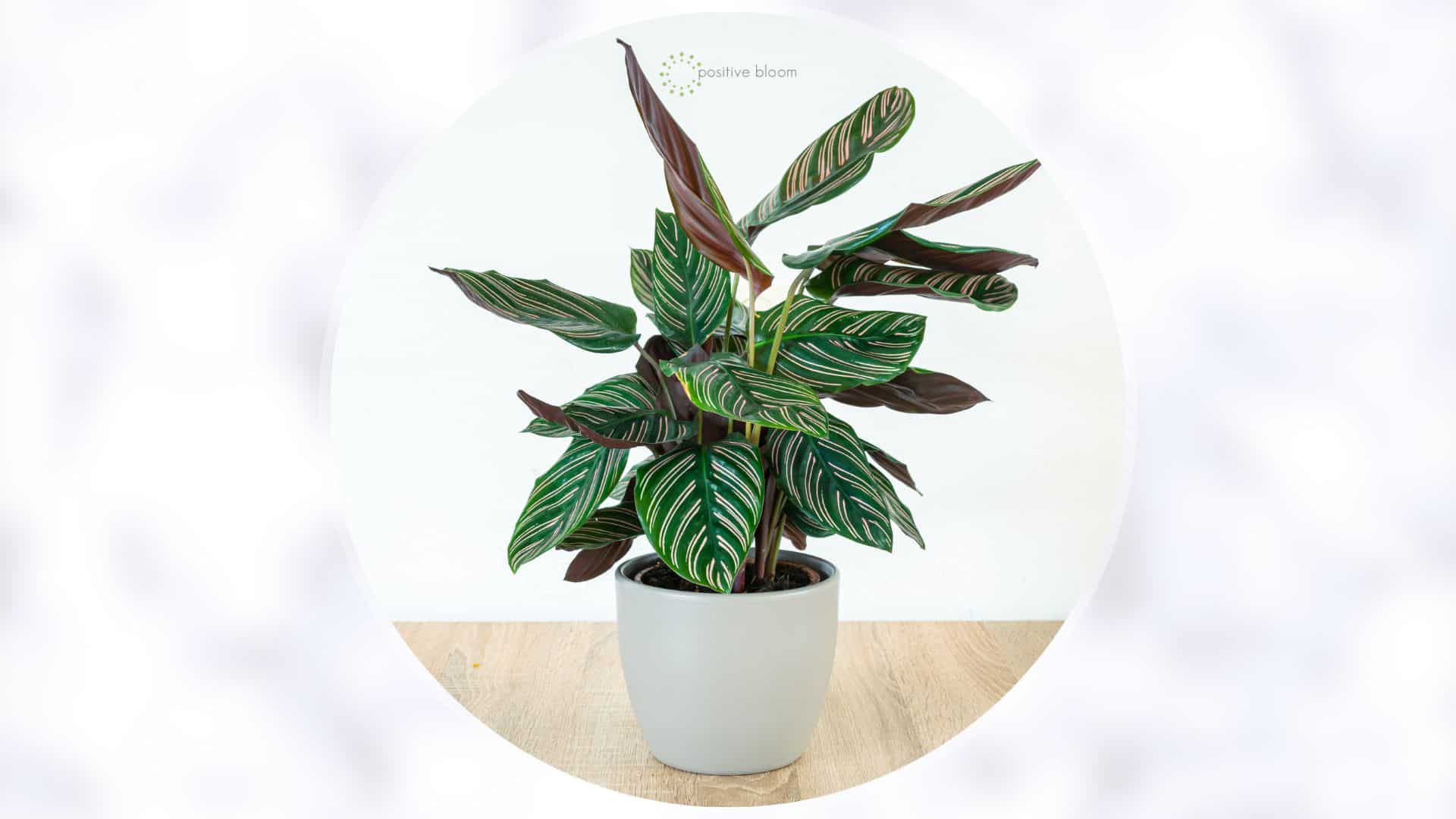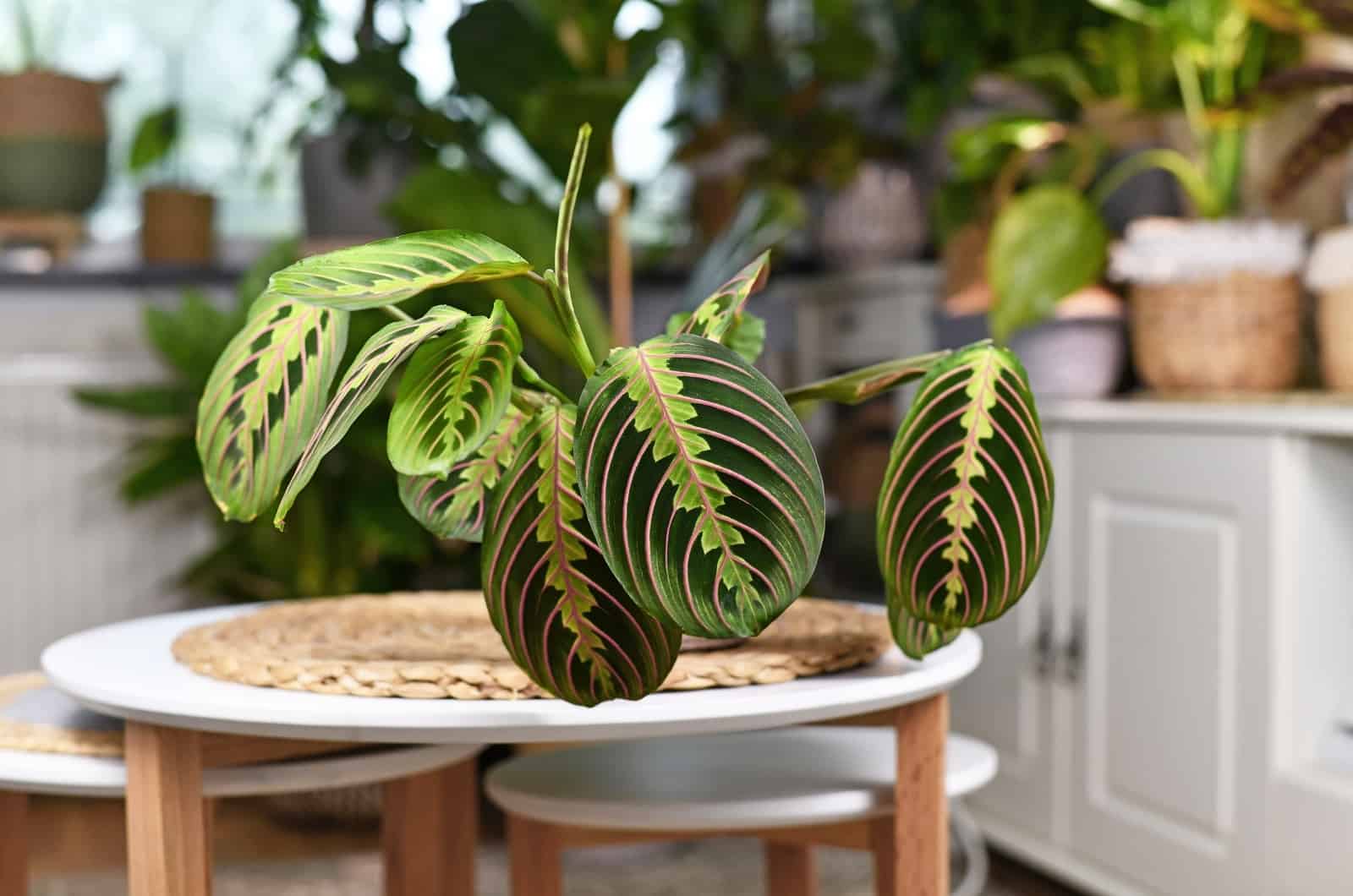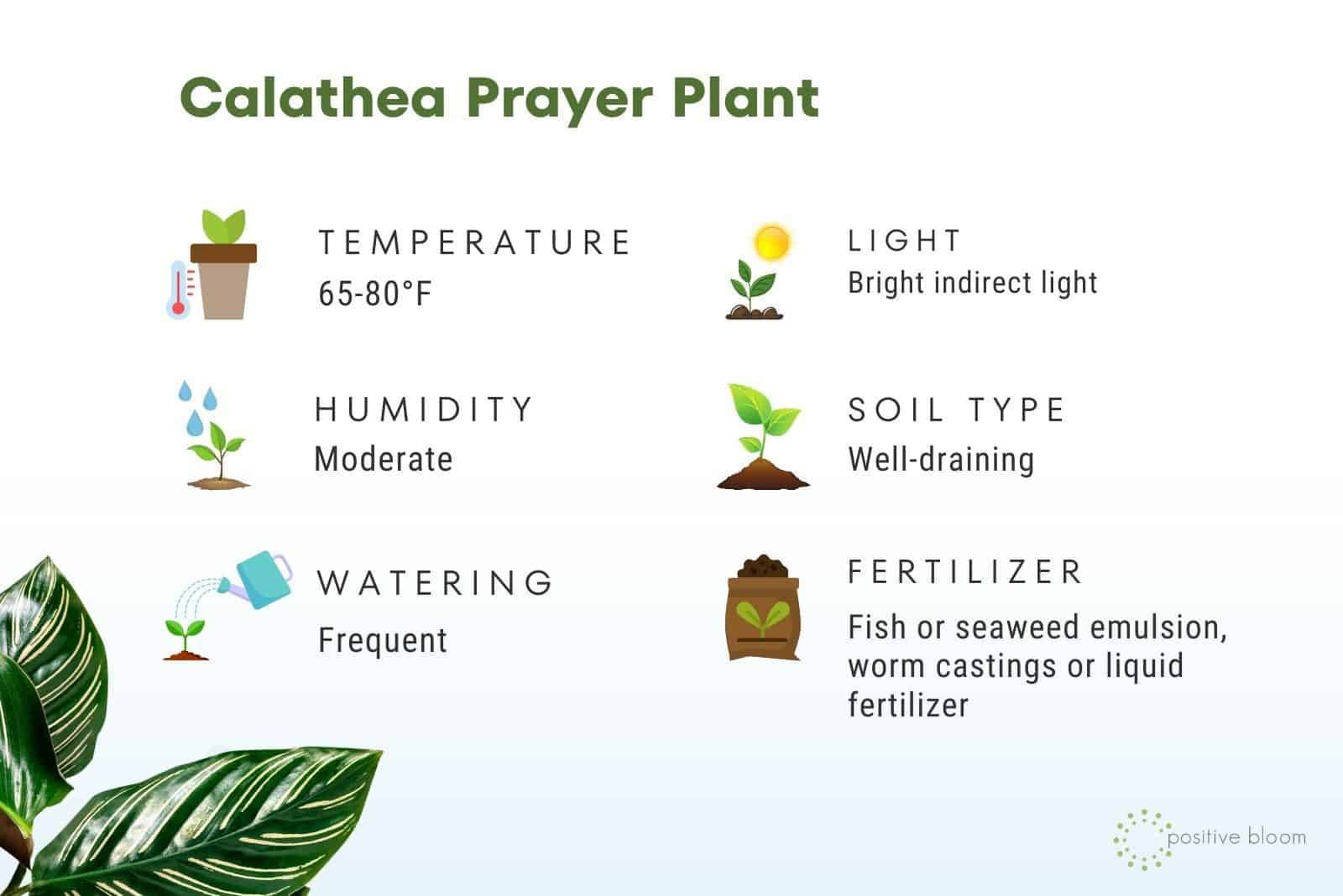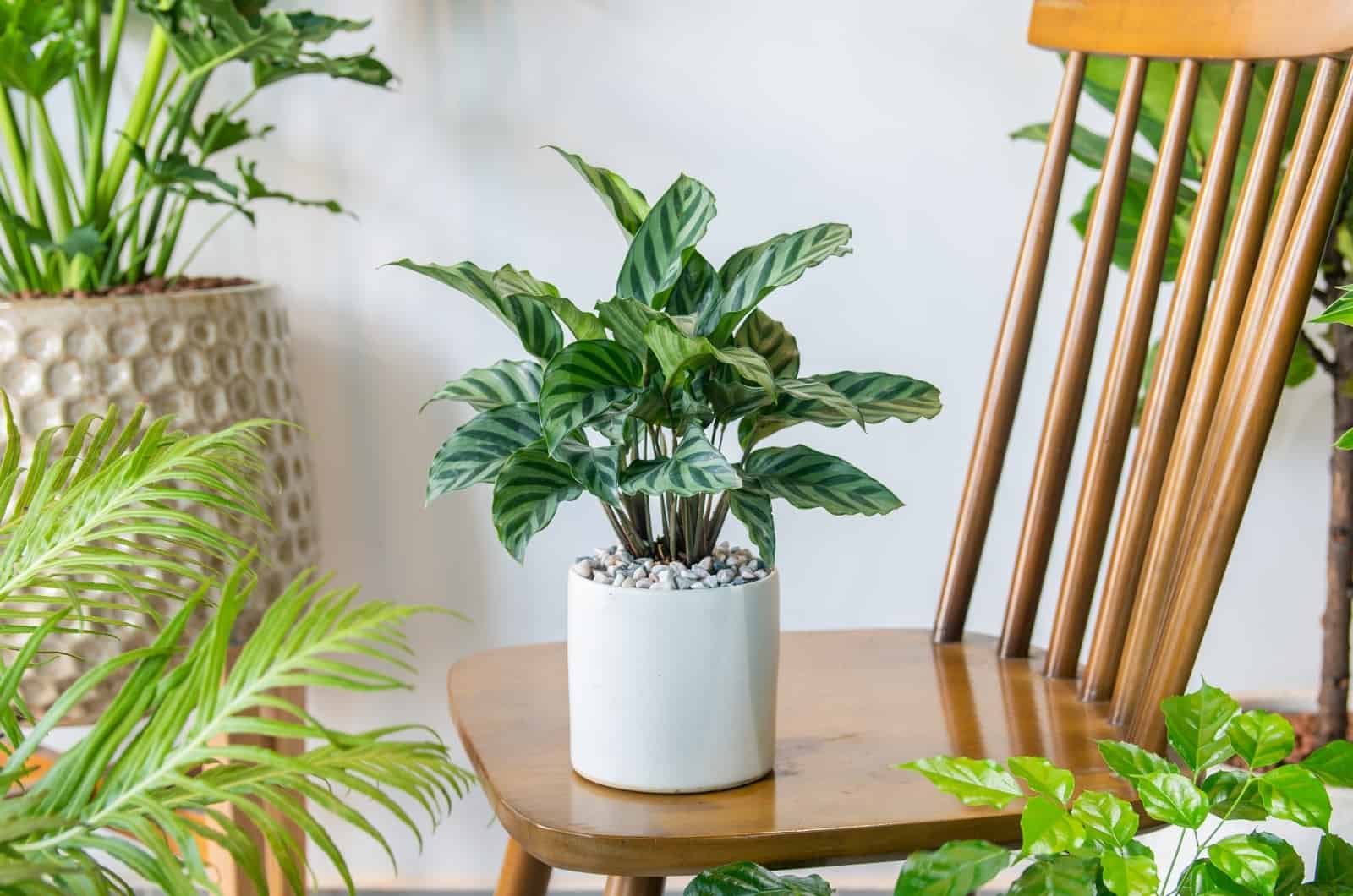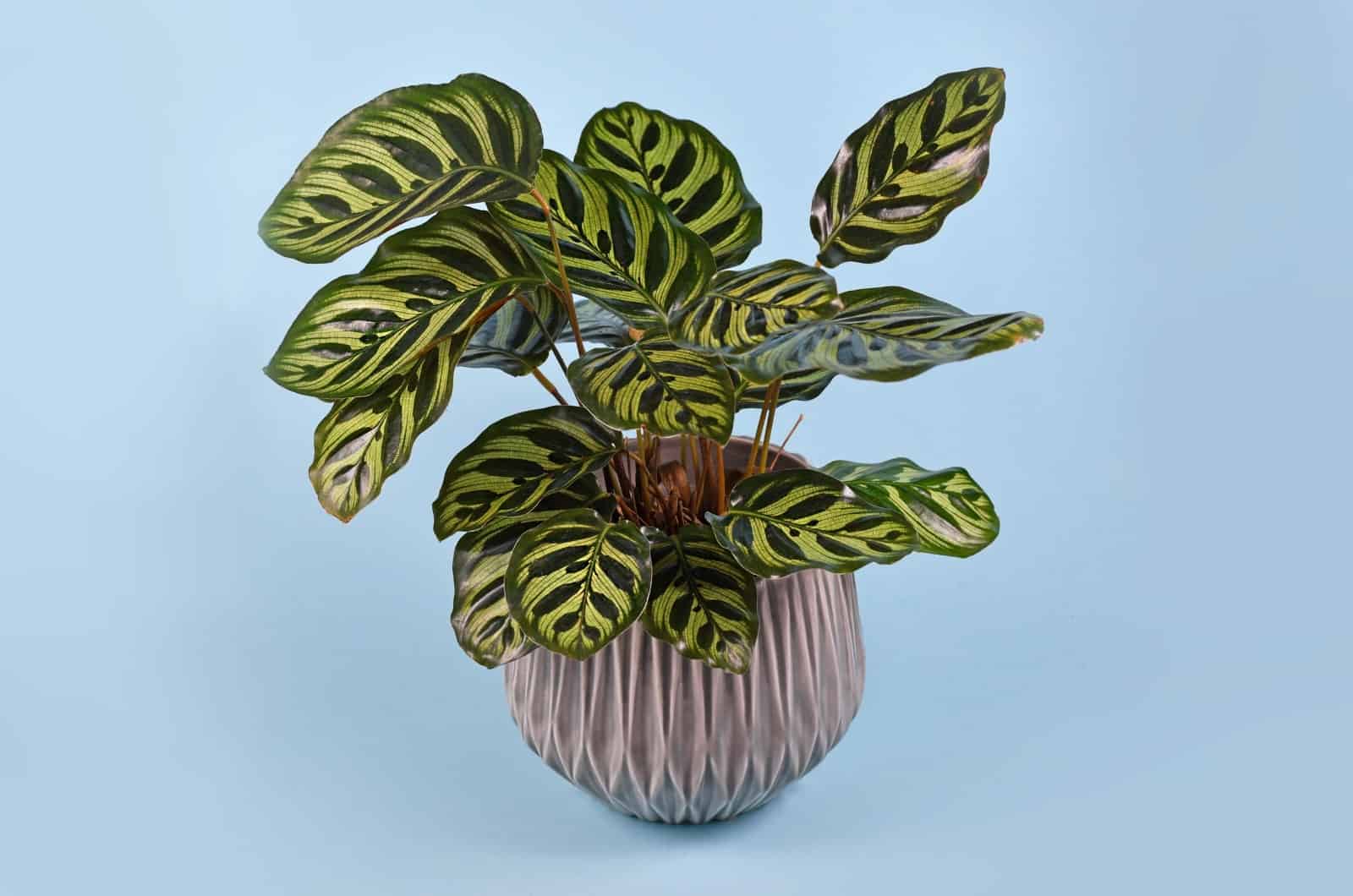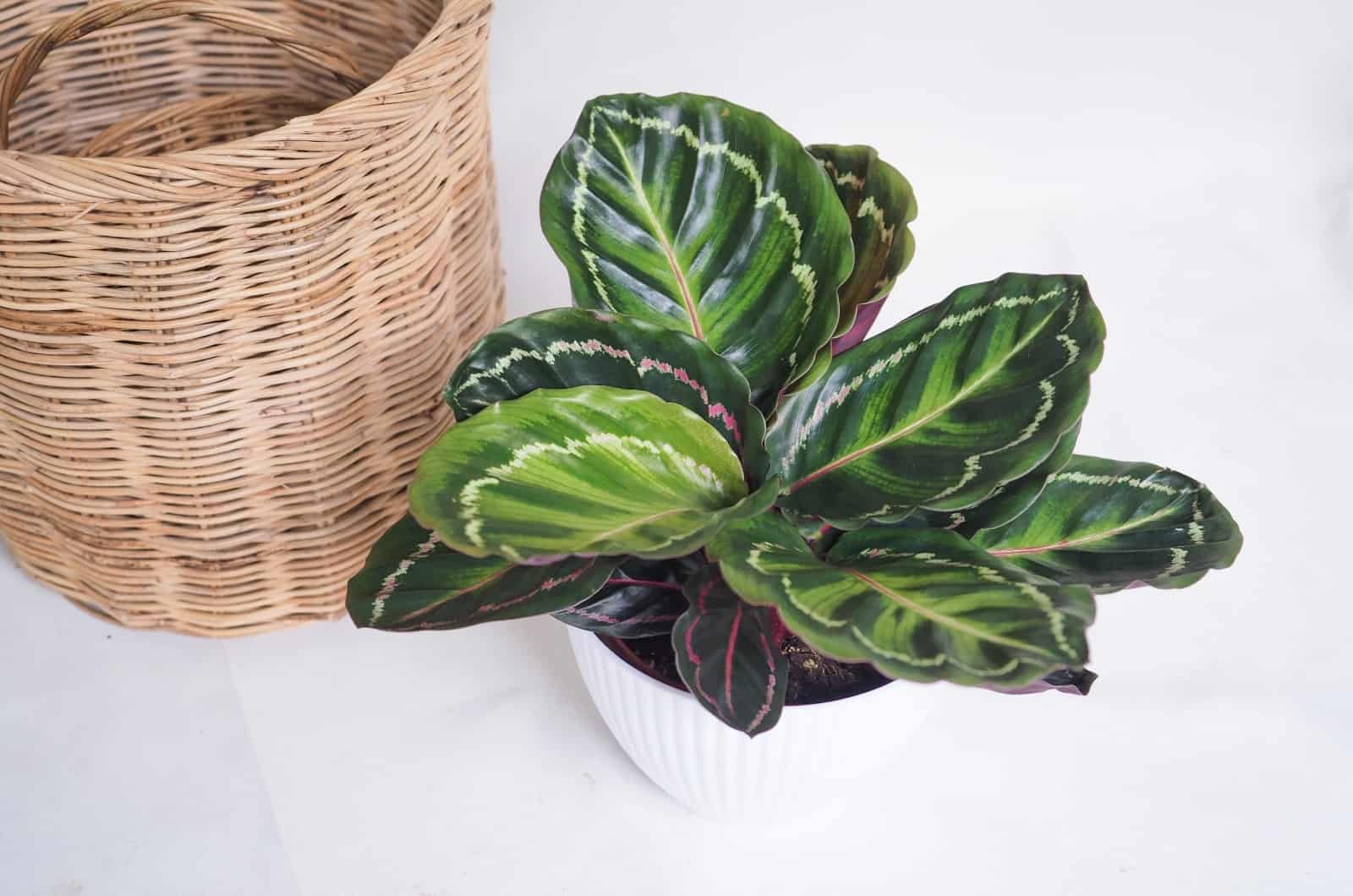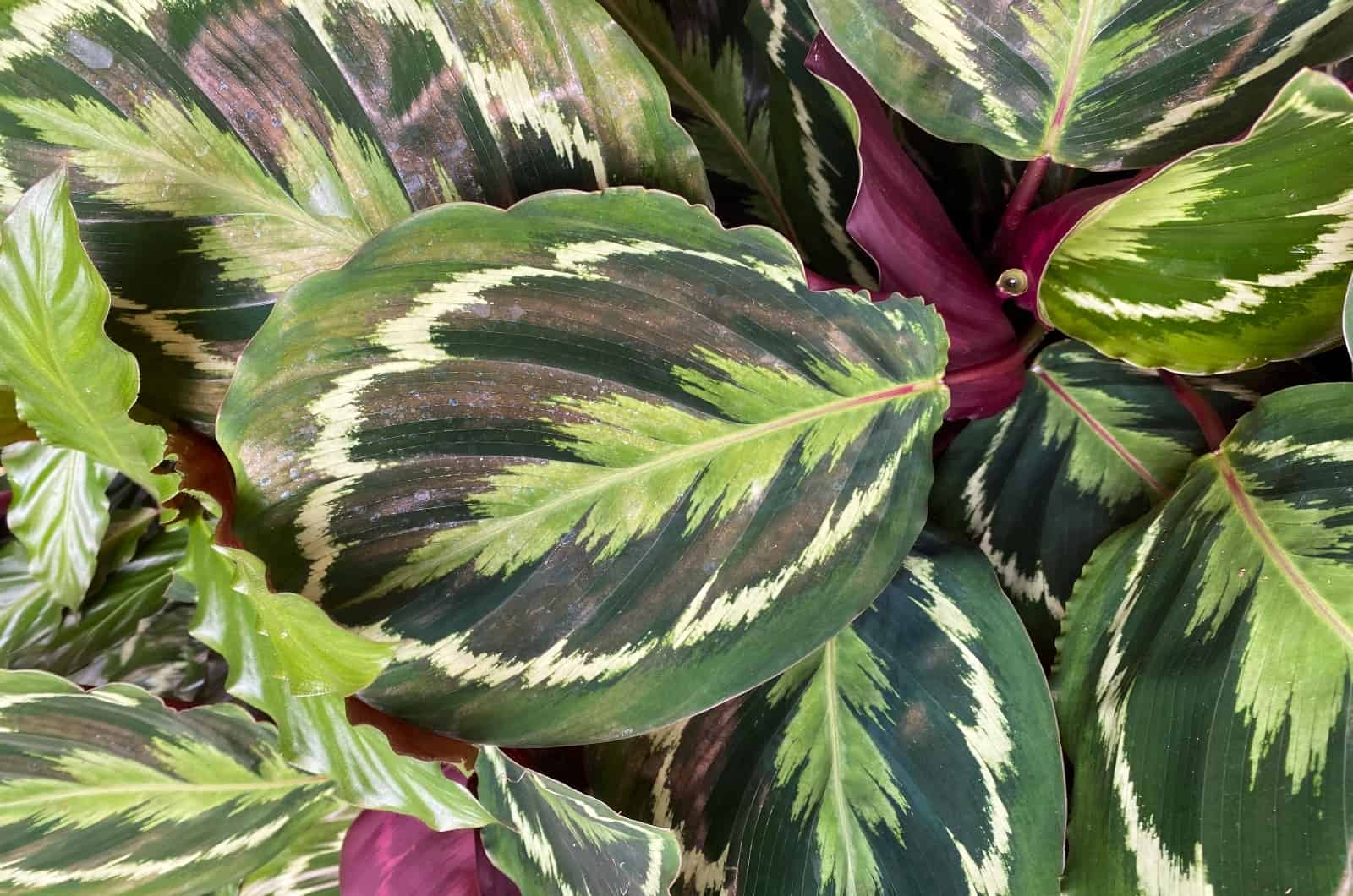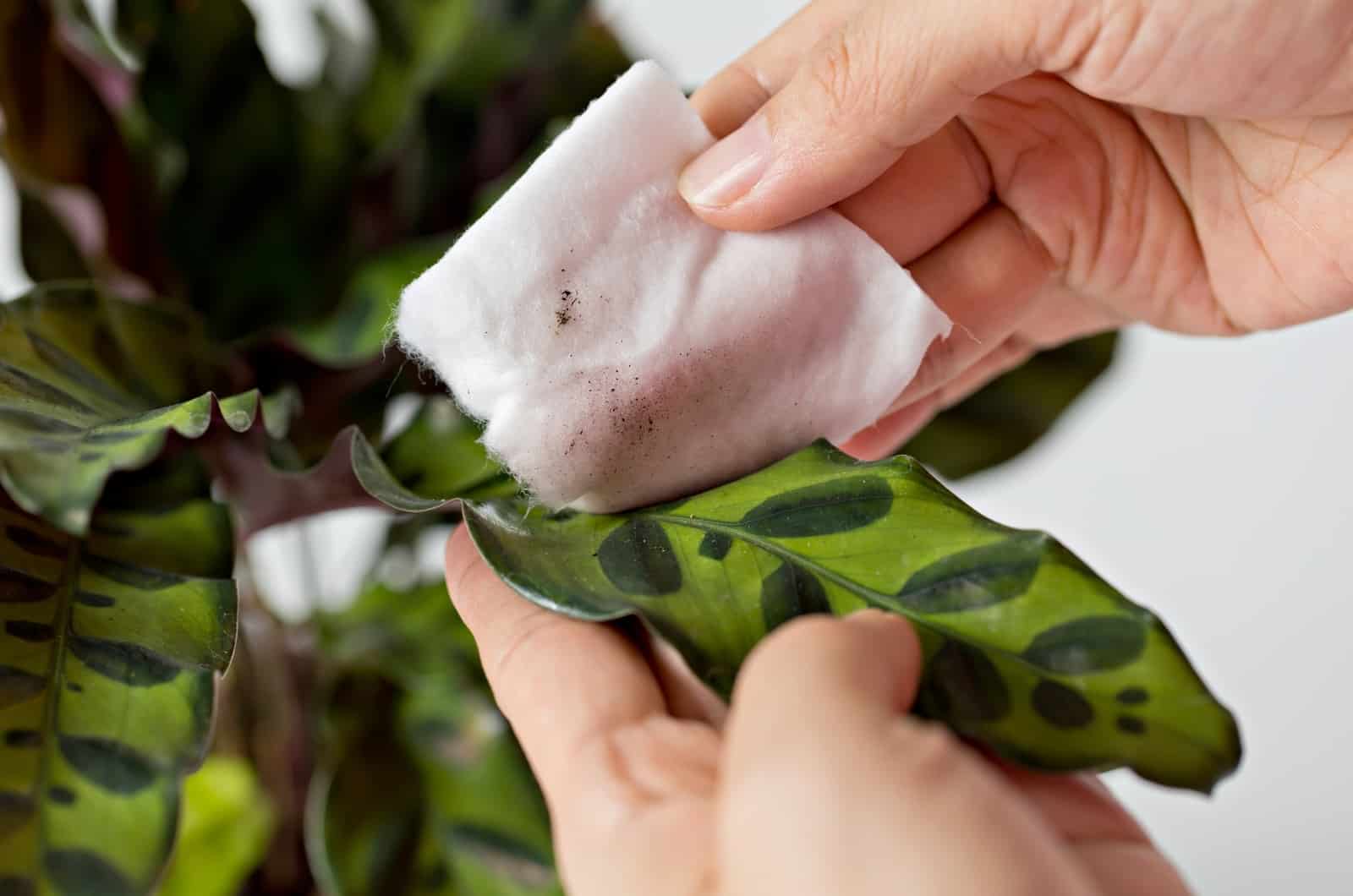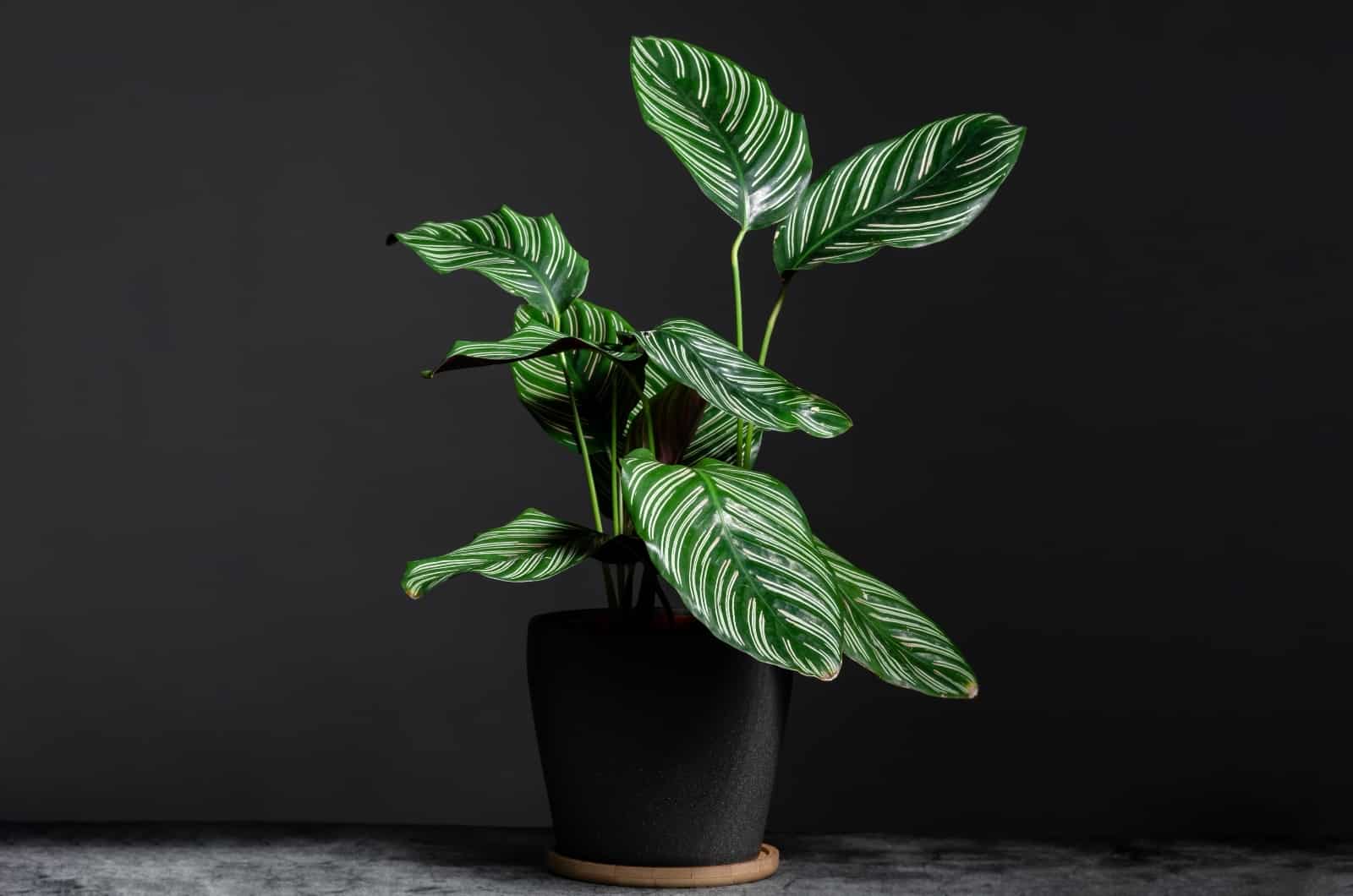Calathea prayer plants are tropical plants that are commonly grown indoors. These are not your typical tropical plants – they all share a characteristic feature called nyctinasty. This natural phenomenon allows plants to close their leaves during the night and open them again in the morning.
It looks like these plants are praying, which is why they got the name prayer plants!
As well as Calatheas, there are other plants referred to as prayer plants, including Maranta, Stromanthe, and Ctenanthe species. You can definitely find the one that suits your style since there are over 500 different prayer plants out there.
Aside from their unique characteristics, these plants are also relatively easy to take care of. All you have to do is make sure that they are nice and warm, and give them some water so that they are not thirsty.
Let’s look closer.
Calathea Prayer Plant: Common Features
Calathea plants have distinctive leaf patterns and textures that immediately take your breath away. Even the undersides of the leaves add visual appeal because of their vibrant pop of color.
These plants can reach about 2 feet tall when they are kept in optimal growing conditions. Their growth rate is moderate, so you won’t have to worry about repotting them every season.
They are native to tropical regions in America, and there are around 60 Calathea species. Here are the top Calathea varieties:
• Calathea fasciata – this is a popular plant since it produces dark green leaves with striking purple undersides. The leaves also have unique patterns and prominent veins along the surface.
• Rattlesnake calathea – this plant produces wavy, long green leaves with patterns that resemble a reptile’s skin. The undersides of the leaves have a prominent purple color.
• Calathea orbifolia – one of the largest Calathea varieties. This plant has large, oval-shaped leaves with light green colors and variegations.
• Calathea White star – this variety also has oval-shaped leaves, though they have white-stripped variegations all over the dark green leaves.
• Calathea roseopicta – this plant features beautiful, broad green leaves with unique variegations. The purple undersides of the leaves create a magnificent contrast.
• Calathea Maui queen – this rare Calathea variety has long green leaves with subtle variegation along the midribs.
How To Take Care Of The Calathea Prayer Plant
These plants might seem like they are high-maintenance, but in reality it is really easy to take care of them. Just like any other tropical plant, these little prayers like nice and warm temperatures with just enough water to keep them happy and healthy.
Let’s look at their care guide in more detail.
Temperature Requirements
We will start off with temperature requirements. Since the Calathea prayer plant originates from tropical regions, they are used to growing in warmer temperatures.
These plants thrive in a temperature range from 65 to 80 degrees Fahrenheit.
Some varieties can grow better in lower temperatures, though they are not fans of temperature fluctuations. It may be difficult to keep your Calathea alive and healthy throughout the winter because excessive heat from heaters can harm it severely.
Cold drafts and air conditioners can harm your plant the same as space heaters, so keep your plant away from them as well.
They can be grown outdoors in USDA hardiness zones 10 and 11. However, if the temperature drops below 60 degrees Fahrenheit, bring your plant indoors. If you don’t live in this area, I would recommend growing your plant inside.
Soil Requirements
This is the most important part of any prayer plant’s care guide. First of all, the soil for these plants must be well-draining. However, Calatheas demand consistently moist soil, so the potting mix should have components that effectively hold onto water.
There are commercial soil mixtures made specifically for Calatheas, but you can also create your own. A solid foundation is the first thing you need. I usually start with standard potting soil and then add the soil additives.
When it comes to supplementing soil, you have many possibilities. Peat moss or charcoal elements will assist in the soil’s ability to hold moisture.
On the other side, substances like coco coir, pumice, perlite, and orchid bark will improve drainage.
You can combine:
• 50% potting soil
• 20% charcoal
• 20% orchid bark
• 10% perlite or pumice
The soil should also be rich in nutrients, so consider adding organic matter or fertilizers. The perfect pH level varies between 6.5 to 7.0. You should also grow your plant in a pot with drainage holes in the bottom to prevent overwatering.
Water Requirements
Water requirements are also very important when it comes to Calathea plant care. You will have to provide them with constantly moist soil. But how do you do that without suffocating your plant?
The roots will suffocate if you water too frequently and water starts to build up in the soil. Your Calathea will wilt and deteriorate if you don’t add water for an extended period of time.
So what do you do? If you can believe it, the solution is as easy as checking the soil’s moisture content before adding any water. Actually, there is no other method to ensure that your Calathea has the ideal level of water—neither too much nor too little.
Once the top two inches of soil have dried out, check the plant and then water it.
The lack of a set watering schedule for this Calathea plant has an easy explanation. The demand for watering is impacted by several variables, including temperature and humidity levels.
During the warmer summer months, your Calathea will require more water, and less water while it is dormant. You can easily overwater it if it grows in high humidity. Because Calathea plants are extremely delicate and could be damaged by numerous minerals and compounds present in tap water, the type of water should also be taken into consideration.
For instance, the fluoride and chlorine in tap water can turn the leaves of Calathea brown. For your Calathea, you can change the tap water for distilled or filter water.
Humidity Requirements
One of the reasons calathea plants have large, sturdy leaves is so they can absorb moisture from the surrounding air. On the contrary, dry air and low humidity levels can cause the leaves to begin losing water, which causes the leaves of Calathea to curl.
Although they thrive at 75% humidity, these plants may tolerate humidity levels as low as 50%.
If your air is quite dry, there are simple tricks that you can use to improve humidity. Simply put some water in a spray bottle and sprinkle your Calathea every other day. A pebble tray is an alternative; all you have to do is set your Calathea plant in a tray of water with pebbles on top of it (just be careful that the leaves aren’t in the water or they’ll rot).
A humidifier can also be used. This is the best technique to increase humidity in your home, though it is a bit pricey, but it is definitely worth it because your little prayer will love it!
You can try and group your plants to create a microclimate, or simply put your plant in a humid room like a bathroom or kitchen.
Light Requirements
Calatheas are native to rainforests and do well in regions with some shade.
Although they can tolerate low light settings, most Calatheas like bright indirect light. Positioning it close to a window with minimal direct sunlight exposure during the daytime would be great.
The prayer plant’s leaves will scorch in direct sunlight and become curled and droopy. On the other hand, it will grow leggy and lose its glow if you keep it in a dark place.
To ensure that your Calathea receives adequate light without being exposed to harsh sun rays, place it near an east-facing or north-facing window. Remember that the amount of light affects how much water plants need, so direct or low light will cause watering problems as well.
Fertilizer Requirements
This plant is also very easy to grow because it requires little fertilizer. The only time the plant requires fertilizer is during the growing season (late spring to early summer).
You can use a variety of fertilizers, such as fish or seaweed emulsion, worm castings that resemble compost, or a full liquid fertilizer. All liquid fertilizers should be diluted to the specified strength. Depending on the size of the plant, you may not need to fertilize for 1-2 months if the soil around your plant already has a slow-release fertilizer that was applied at the beginning of the growing season.
Be careful not to overfertilize your Calathea prayer plant, as the chemicals and salts can build up in the soil, which would burn the plant’s roots and prevent them from absorbing water and nutrients.
Repotting
Calatheas don’t grow rapidly, so you won’t need to repot them frequently. Once the roots begin to protrude through the drainage holes or above the soil level, your Calathea will require repotting.
You should repot these plants in the spring. Prepare a pot that is slightly larger than the current one, and use a fresh potting mix. Check the roots to see if there is any rotting. Trim off mushy and brown roots.
Remember that the new pot should also have drainage holes.
Pruning
You also won’t have to worry about regular pruning. If you see any dead or wilted leaves, you should prune them. Dead leaves can be removed to encourage the growth of fresh, healthy leaves.
However, you must always sanitize the pruners before pruning.
By sterilizing, you can prevent additional issues like infections and decrease the plant’s susceptibility to pests.
Propagation
Calathea prayer plants are surprisingly easy to propagate. They grow by producing and spreading rhizomes, which are used for propagation. Therefore, root division is the method that is used for propagating Calathea plants.
Before propagating a plant, make sure the mother plant is healthy to avoid stunted growth or no development at all!
Follow these instructions for successful propagation:
1. Your new plant will flourish if those little rhizomes are kept in a warm, moist environment.
2. Provide this plant with the ideal soil conditions (this also applies to the pot).
3. Plant the rhizome and cover the pot with plastic wrap to retain heat and moisture.
4. To prevent sun damage, put your new plant in a dimly lit area.
For more information, check out this video:
Calathea Prayer Plant Common Issues
Even though these plants are relatively hardy, you might still run into some problems. Inadequate plant care is your biggest enemy since it is usually accompanied by increased pest susceptibility. Plant diseases might also appear due to incorrect plant care.
Taking good care of your plant is the key!
However, we will still go through some specific issues in more detail. If you are having troubles with your plant, keep reading to find out why.
Plant Diseases
Remember when we mentioned that overwatering is bad and should be prevented at all costs?
Well, this is because too much moisture attracts lots of fungi, including the one that causes a deadly plant disease known as root rot.
The most typical symptoms of root rot include wilting, squishy soil, unpleasant odors, and yellow leaves with brown patches.
The best thing to do if your Calathea has root rot is repot it. Take it out of the contaminated soil, cut off the infected roots, and then repot it in a new container.
Once more, pick soil that drains properly and containers that have drainage holes.
Pest Infestation
Even though they are tiny and invisible to the naked eye, these little critters can still devour your plant’s exquisite leaves. Scales, mealybugs, spider mites, and various fungi can all infiltrate your Calathea.
Although you might be having a hard time spotting these tiny villains, if you closely inspect your plant, you will see distinguishing traits that are particular to each kind of insect.
For instance, if the leaves have a sticky material on them, you are dealing with scales. If you observe white, fuzzy material on the leaves of your plant, mealybugs are probably the cause.
If you notice little white or yellowish patches and webbing on the leaves, spider mites are to blame.
I advise applying neem oil, insecticidal soap, or rubbing alcohol if you have pest problems. You will need to apply chemical pesticides to your Calathea in the event of a serious infestation.
Leaves Malformations
Yellow leaves, brown leaf tips, and curling and drooping leaves are the most common issues with leaves that usually arise due to wrong growing conditions.
You should avoid using tap water that contains minerals, fluoride, or salt if you see brown tips on the leaves. Remove the brown leaves and switch to filtered water.
If a Calathea plant doesn’t receive enough humidity, its leaves will become yellow. Buy a humidifier, mist your plant, or find some other way to raise humidity.
When the plant has root rot or another infection, or when it doesn’t get enough water because it’s too hot, the leaves may curl or droop. By curling, the leaves decrease their surface area to reduce water loss.
Underwatering will cause the leaves to curl inward or upward. The plant may appear lifeless or the leaves on your Calathea may droop. Soaking your plant is a good solution. Continue to follow the watering schedule and water it more frequently until you notice an improvement.
Remember that when the weather changes, so does the watering schedule.
To Sum Up
Calathea prayer plants are one of the best plants out there!
They look absolutely magnificent with their big leaves and unique leaf patterns, and they are also really easy to take care of. All beginner gardeners should practice propagation with these plants since they are so easy to propagate.
Keep an eye out for pesky pests and ensure that you are giving the plant just enough water because inadequate watering is a source of many problems that can completely ruin your plant.
That’s all, folks. I hope this article was helpful.
Until next time!

